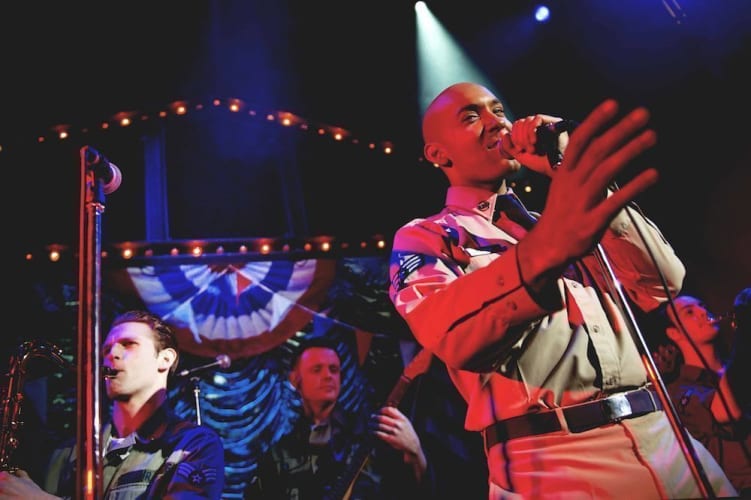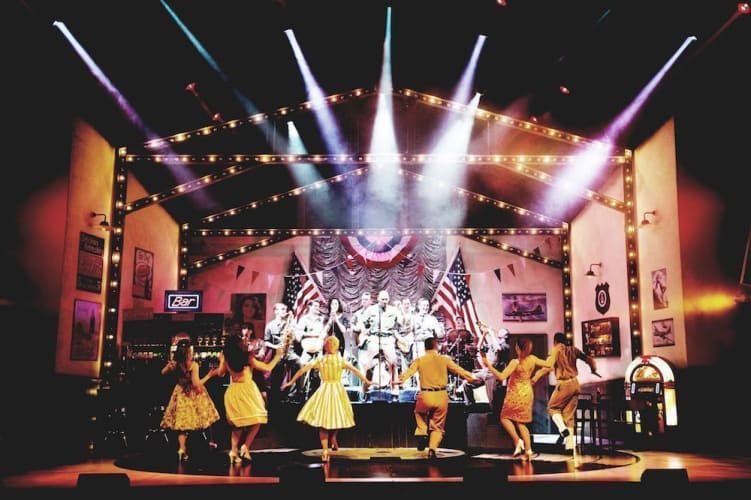As the house lights go down, a voice, not unlike the voice of producer / director Bill Kenwright, informs us that we shall surely recognise many of the songs in tonight’s show and that we should feel free to sing along with the cast. It’s an invitation many of the baby-boomers in the crowd seize with both vocal cords.
It’s the summer of 1963. (If that date resonates with aficionados of the musical, it could be because around this time, in upstate New York, Baby is having her life-changing lessons in ‘dirty dancing’).
We, however, are in Lowestoft, where racy Jennifer and her prim 17-year-old sister Marie are sharing a caravan holiday away from the protective gaze of their parents. The two meet a US Airforce man, Milton, who invites them to the nearby base, where (according to Milton) Elvis will be performing. Needless to say, Elvis is nowhere to be seen, but this doesn’t stop Jennifer having some fun with Milton.
Little sister Marie, meanwhile, develops an instant crush on his pal, Curtis. As if falling for an American isn’t already a fate worse than death for an English rose, this particular American happens to be a ‘person of color’.
Fear not, dear reader, for this is not only England, it is the England of Laurence Marks and Maurice Gran (the writing team who brought us Goodnight Sweetheart). So, whilst back home in Memphis, Tennessee, Curtis might face lynching for even smiling at a white girl, the worst he has to encounter here is being called ‘Harry Belafonte’ by an Italian ice cream seller with a Wolverhampton accent.
Happily, Carlo, the ice cream seller in question, is just having a bit of innocent if ignorant fun and, on hooking up with Jennifer, shows he has a heart-of-gold by doing his gormless Black Country bit to bring the star-crossed lovers (Marie and Curtis) together.
Time is against them—the sisters have to go home to Luton at the end of the week. The US Airforce is (inadvertently) against them—trying to post Curtis to Frankfurt. Most of all, of course, while the young folk know ‘we’re all the same under the skin’, Marie’s mother and father are dead set against their youngest child falling into the clutches of a ‘person of colour’. They even stoop to intercepting the airman’s letters to their daughter. Black-hearted villains, indeed! How will it all end? Have a guess.
The script has a smattering of the writers’ trademark humour, though this leans heavily on what Churchill called ‘two nations divided by a common language’—the Americans have endless fun over the fact that we Brits call a period of two weeks something quaint like a ‘fortnight’, and when Jennifer asks Milton if he has a ‘fag’...well, you get the idea.
Nostalgia is plastered on with a trowel—petrol at the outrageous price of ‘four bob a gallon’ raises a laugh, as does the mother’s tactless reference to Marie’s fondness for Robertson’s marmalade (given what those of a certain age will recall used to be found on the side of the jar).
Regarded with a gimlet eye, this show could be deemed a formulaic leap on the bandwagon: a holiday in 1963 where an innocent young woman undergoes a rite of passage, defying her parents by falling for an “unsuitable” man (Dirty Dancing); a thin plot woven around songs by a successful writing team (Mamma Mia—only here the composers are Doc Pomus and Mort Shuman, not Benni and Bjorn).
Happily for the audience, while the script is less witty than Catherine Johnson’s Mamma Mia, and far less layered than Eleanor Bergstein’s Dirty Dancing, the music, at least, stands up to scrutiny. Pomus and Shuman were an incredibly productive writing team for Elvis, the Drifters, the Searchers, Andy Williams and many more.
Kieran McGinn (Curtis), Elizabeth Carter (Marie), Lee Honey-Jones (Milton), Verity Jones (Jennifer) and Jay Perry (as Military Police Sergeant Rufus) all turn in creditable singing performances, whilst acting as well as the functional directing of an average script will allow. The star vocal performance of the evening, though, belongs to Alan Howell’s Carlo, in a truly beautiful rendition of “Hushabye” with fine a capella backing from the company.
Mark Bailey’s set and costume design work well enough on what seems to be a tight budget, while Bill Deamer’s choreography captures some of the flavour of the times, without ever really setting the pulse racing.
The songs are so good (as are the band) that it would be churlish to deny that the majority of those present are having a good time, singing along. At the finale-cum-built-in-encore, one or two are up and dancing.
If you’re sufficiently old or contrarian to hold that most of the great pop music was written before those four upstarts from Liverpool arrived, Save the Last Dance for Me might be just what you’re looking for.


